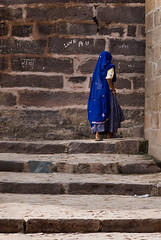Tuesday, December 07, 2010
In Search of Love
I am still blue.
Monday, December 06, 2010
Simple Guidelines to possibly Better Pictures
At the very outset, I would like to state my case. I believe that a beautiful picture is one that appeals to the viewer. And I believe that the most important viewer is the creator of that picture. If you as the creator, the author of the image are satisfied, that is most of the battle won. But as you walk further down the path with the camera around your neck, the weight starts to tell and your eye becomes more critical. Soon enough, the opinions of others start to matter more than before and then it is time to take the next leap of faith.
When I was asked to write this piece, I initially could not think of what I could say that would be useful. So I started looking at my online photostream and tried to figure out what I have tried to do consciously and unconsciously. I discovered that over time, among other things, most of my pictures have in one way or the other fulfilled these guidelines. However, as I stated above, these guidelines are not exhaustive, nor are they inviolate. In fact, some of my most satisfying pictures have come about as a result of not following these guidelines. But, as a rule of thumb these tend to work.
- Use Layers: Once in a while you stumble upon a scene where there is a lot happening and it is often tough deciding what to include and what not to. Sometimes it is prudent to include all that you find interesting, especially if these elements tend to occur in layers. It is great if you can find a single point of focus around which all the action occurs, but that is definitely not a necessity. In this photo that I made with a medium telephoto lens, I had this clothesline in the foreground followed by the river Yamuna, followed by a temple and finally the ghats on the other bank of the river. I could have tried to isolate some of the elements (which I later did), but I found this shot particularly satisfying because for me it was the closest that came to my experience that evening. http://www.flickr.com/photos/shubh/5178310676/in/set-72157624623469888/
- Draw them in: If your point of interest is further up the frame, it is often a good idea to use some of the elements around to let the eye of the viewer be guided up to it. This shot for instance was taken from a moving car as I crossed a railway crossing, the three boys moving on the railway tracks looked interesting enough, and the rails curving away to meet them completed the picture for me. http://www.flickr.com/photos/shubh/4406005930/ http://www.flickr.com/photos/shubh/5228388795/
- Off-centre composition: Sometimes you have to decide what to do with your subject and where exactly you want him to be in your frame. You do not have anything that you can use as a prop or to make the scene more interesting. At those times, an off-centre composition is a safe choice. This priest sitting on the stairs would probably not look as poised if I placed him bang in the centre. http://www.flickr.com/photos/shubh/4529703093/ Sometimes though, it is a good idea to break the rule. This shot is one of my favorite tiger images, and I would not have it any other way. http://www.flickr.com/photos/shubh/4746327110/in/set-72157624260314889/
- Use of negative space advantageously: Negative space or space where there is no action can often be used advantageously. It can be used to give a sense of scale, a sense of movement or a sense of loneliness. This boat in the Chilika Lake in Orissa looked frail and lonely in the vast expanse of the lagoon. I tried to use the space around to emphasize this feeling. http://www.flickr.com/photos/shubh/4507034113/
- Get close and intimate if you can: Zoom lenses sometimes make you lazy. Often you want to get to the essence of your subject. Really feel the texture and the toughness of the skin, smell the sweat so to speak. That is when you need to get in close if you can and really isolate your subject and fill up your frame with your subject. I met this man who was selling Toddy (a local alcohol made of fermented juice) in a small village in Orissa. His face spoke of a life of hardships and bad weather. The only way I could do justice to his experiences and mine was to go in close enough to get the texture of his skin in my RAW file. I could not have done justice to his kind consent to be photographed if the composition was loose. http://www.flickr.com/photos/shubh/5206554900/
- Explore a different point of view: There are clichés and there are clichéd pictures. Sometimes the way to rise above the humdrum is to try and see it from a new point of view. Often that is what sets your image apart. I have seen a lot of fisherman photos, and I had a chance to look down from a bridge on to the river below. Down below, I could see a fisherman trying to catch some fish and the next day I came back with a camera to explore this possibility of a different point view. I think I succeeded in doing something different even though the result could possibly have been better. http://www.flickr.com/photos/shubh/5203562511/
- Explore lines and shapes: In an urban world, the landscape is increasingly changing from free flowing forms to straight lines and geometric shapes. In Delhi and other metros, all I see is straight lines and angles. And these can often be explored to give an occasional interesting result. I made this image while I was waiting at a traffic light, waiting for it to change from red to green. I had a camera with me and just to while away those 120 seconds, I looked around and made this picture. http://www.flickr.com/photos/shubh/5200456531/
- Try to capture a fleeting moment: Famous photographers such as Cartier-Bresson took this art of capturing the decisive moment to dizzy heights. It is tougher than it looks seeing the deceptively simple photos of these giants. However, at the outset, it is often useful to capture a movement at just the right time to give an otherwise humdrum image an added point of interest. I was exploring a 300mm lens in sector 17, Chandigarh when I saw these pigeons fluttering around the plaza. I tried to get the pigeon at exactly this point in its flight. http://www.flickr.com/photos/shubh/5192716632/
- Two is better than one: As the name suggests, when there is a possibility to go double, why be satisfied with a single. When there is some action going on around you, it is often possible to duplicate it and give it a new meaning and added interest. Reflections are only one way as I have explored in this photo. It is fun and interesting to use shadows, or other moving elements to create sympathetic elements to your main subject. http://www.flickr.com/photos/shubh/5181721597/
In the end, I would like to emphasize that most important thing is to have fun. And if in the process it is possible to quench a creative urge or even earn a livelihood, all the better.







